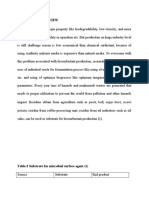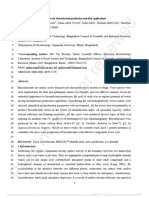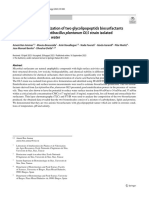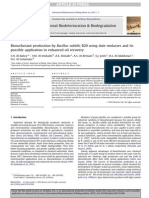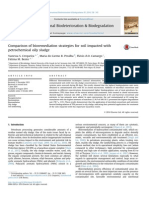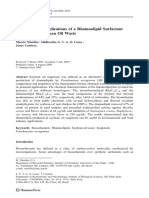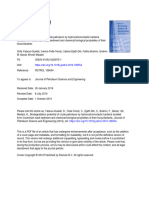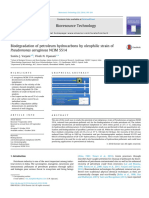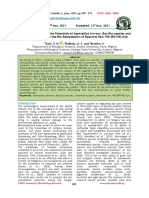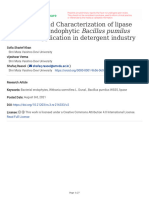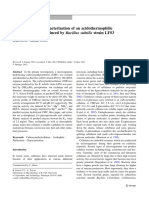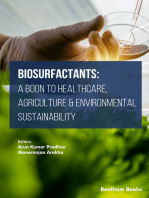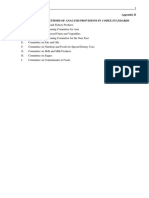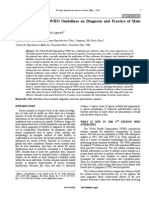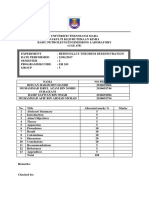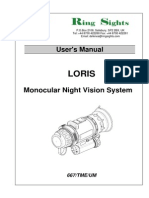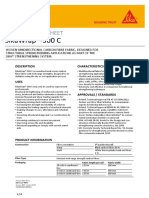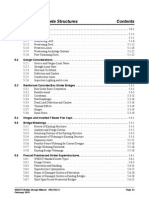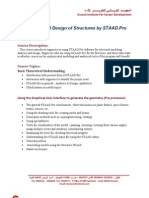Research 8
Research 8
Uploaded by
mostecocCopyright:
Available Formats
Research 8
Research 8
Uploaded by
mostecocCopyright
Available Formats
Share this document
Did you find this document useful?
Is this content inappropriate?
Copyright:
Available Formats
Research 8
Research 8
Uploaded by
mostecocCopyright:
Available Formats
Malaysian Journal of Microbiology, Vol 10(1) 2014, pp.
57-62
Malaysian Journal of Microbiology
Published by Malaysian Society for Microbiology
(In since 2011)
57 ISSN (print): 1823-8262, ISSN (online): 2231-7538
Production of biosurfactant by Pseudomonas aeruginosa PB3A using agro-
industrial wastes as a carbon source
Varadharajan Saravanan and Subramaniyan Vijayakumar*
Department of Botany and Microbiology, A.V.V.M. Sri Pushpam College, Thanjavur-613 503, Tamil Nadu, India.
Email: svijaya_kumar2579@rediff.com
Received 30 July 2013; Received in revised form 1 October 2013; Accepted 7 November 2013
Aims: To evaluate Pseudomonas aeruginosa PB3A strain for the production of biosurfactant using agro-industrial waste
as a carbon source.
Methodology and results: P. aeruginosa PB3A strain was isolated from oil contaminated soil and was found to be a
potential biosurfactant producing microorganism based on the following screening methods; hemolytic activity, drop
collapse test, emulsification activity and surface tension measurement. The identification of the isolate was confirmed by
16S rRNA sequencing. The isolate exploited for the application of agro industrial wastes such as used castor oil,
coconut oil, corn oil, motor oil, olive oil, olein, rapeseed oil, sunflower oil, barley bran, cassava flour waste, peanut cake,
potato waste, rice bran and wheat bran for biosurfactant production by replacing the existing carbon source. Among the
cheap substrates, both the used corn oil and cassava waste flour showed maximum productivity of 0.62 mg/mL and 0.60
mg/mL respectively when cultivated independently in the MSM medium.
Conclusion, significance and impact study: Present study was aimed at the application of agro-industrial wastes for
biosurfactant production. The study indicates that agro-industrial wastes can be used as inexpensive substrates by
replacing synthetic media for the production of biosurfactant.
Keywords: Toxicity, agro-industrial wastes, biosurfactant, drop collapse, hemolytic assay, surface tension.
INTRODUCTION
Surfactant belongs to amphiphatic molecules, consisting
of a hydrophobic and a hydrophilic group which helps in
reducing the surface and interfacial tension in
water/hydrocarbon systems (Prantera et al., 2002). The
application of synthetic surfactants for the treatment of
hydrocarbon-contaminated soil improves the restoration;
however, they get accumulated in the ecological system
leading to severe environmental damage. The
biosurfactants or the surface active component
synthesized by the microorganisms appears to be an
excellent alternative approach for the synthetic
surfactants. Besides possessing surface and emulsifying
activities (Van Hamme et al., 2006; Singh et al., 2007)
these bio surfactants exhibit antimicrobial and anti
adhesive properties (Singh and Cameotra, 2004;
Rodrigues et al., 2006). Microbial surfactants composed
of diverse group of surface-active components are
classified by their chemical composition and microbial
origin which include lipopeptides, glycolipids,
lipopolysaccharides, polysaccharide-protein complexes,
protein-like substances, fatty acids, phospholipids, and
neutral lipids (Van Hamme et al., 2006).
Distinct properties and physiological functions have
been observed for different groups of biosurfactants
produced by different microorganisms which include
enhanced solubility of hydrophobic compounds, heavy
metal binding, cell adhesion and aggregation, biofilm
formation and quorum sensing (Ron and Rosenberg,
2001; Singh and Cameotra, 2004). Among the various
microorganisms, bacteria are the important group of
surfactant-producers although few yeasts and fungi are
also reported (Desai and Banat, 1997). The most
common biosurfactants are glycolipids and lipopeptides
which include rhamnolipids synthesized by Pseudomonas
aeruginosa (Nitschke et al., 2005), sophorolipids released
by Candida species (Daverey and Pakshirajan, 2009),
and surfactin and iturin synthesized by Bacillus subtilis
strains (Ahimou et al., 2000).
In the present scenario, the major drawback that
prevents the widespread use of microbial biosurfactants is
the economic viability of the production costs. Currently
various strategies have been evaluated in order to reduce
the fermentation process economics and make it
competitive with chemically synthesized surfactants
(Makkar and Cameotra, 2002). Future research on
biosurfactant has to be more focused on the economics of
the fermentation processes, mainly through the usage of
alternative low-cost production media (Makkar and
Cameotra, 2002; Rodrigues and Teixeira, 2008).
*Corresponding author
Mal. J. Microbiol. Vol 10(1) 2014, pp.57-62
58 ISSN (print): 1823-8262, ISSN (online): 2231-7538
MATERIALS AND METHODS
Materials
All the chemicals and reagents used in the present study
were of analytical grade and purchased from SRL
Chemicals and Merck Chemicals, India. Used residual oil
wastes were collected from various shops and household;
agro-wastes were collected from local market and
industries from Chennai and nearby area.
Isolation and screening of biosurfactant producers
Bacterial strains used in this study were isolated from oil
contaminated soils at Chennai as described by
Saravanan and Vijayakumar (2012). The samples were
serially diluted and preserved in nutrient agar slant for
further screening of biosurfactant production. Hemolytic
activity was performed as described by Carrillo et al.,
(1996) with slight modifications. Isolated bacterial strains
were screened for their hemolytic activity on blood agar
plates with 5 vol. % of blood and incubated at 37 C for 24
h. The hemolytic activity was distinguished based on the
presence of a clear zone around the colonies. Using a 96
micro-well plate the drop collapse test was carried out as
described by Bodour and Maier (1998). Two microliter of
crude oil was added to the well and left to equilibrate for
24 h, followed by 5 L of 48 h cell free supernatant of
bacterial strain and the drop size was observed after 1
min with the aid of a magnifying glass. Positive result
shows a flat drop and rounded drops were scored as
negative which indicate a negative result for biosurfactant
production. The emulsifying activity of biosurfactant was
carried out according to Cooper and Goldenberg (1987).
After 48 h, 2 mL of cell free supernatant and hydrocarbon
(oil) was taken in a test tube and vortexed at high speed
for 1 min and left to stand for 24 h. Emulsifying (E24)
activity was expressed as the percentage of the total
height occupied by the emulsion (Bodour et al., 2004).
Surface tension (ST) was determined using a Kruss
processor tensiometer by the plate method (Paza et al.,
2011). The bacterial cultures were centrifuged at 10,000
rpm for 20 min and the cell free supernatant was
analyzed for the determination of surface activity. All the
assays were performed in triplicate with appropriate
positive and negative controls.
Identification of bacterial strain
The selected isolate PB3A was identified by
morphological and biochemical analysis based Bergeys
Manual of Systemic Bacteriology (Holt et al., 1994). The
identity of bacterial strain PB3A was further confirmed by
16S rRNA gene sequence analysis. The total genomic
DNA was extracted from an overnight culture in Luria
Bertani broth using CTAB (Cetyltrimethylammonium
Bromide) method (Ausubel et al., 1994). The 16S rRNA
gene amplification was done by universal 16S rDNA
primers 27f (5- GAGTTTGATCCTGGCTCAG-3) and
1492r (5-TACGGYTACCTTGTTACGACTT-3) followed
by purification using QIAquick Gel Extraction kits from
Qiagen. DNA sequencing was performed using DTS cycle
sequencing kit and Applied Biosystems automated DNA
sequencer (Marchesi et al., 1998). Nucleotide sequences
were determined for both strands. Sequence obtained
was aligned and used for similarity comparisons using the
BLAST program (Altschul et al., 1990).
Production of biosurfactant using agro-industrial
wastes
In the present study, various solid and liquid wastes were
used as cheap substrates for biosurfactant production.
Different waste substrates such as used castor oil,
coconut oil, corn oil, motor oil, olive oil, olein, rapeseed
oil, sunflower oil, barley bran, cassava flour waste, peanut
cake, potato waste, rice bran and wheat bran were
amended in MSM medium by replacing glucose at a
concentration of 1 % in the final composition according to
Tahzibi et al. (2004) (g/L of distilled water: NaNO3, 15;
NaCl, 1.1; KCl, 1.1; KH2PO4, 3.4; K2HPO4, 4.4;
MgSO47H2O, 0.5; FeSO47H2O, 0.00028; yeast extract,
0.5; glucose 1%). The selected strain PB3A was then
inoculated into the medium amended with different
wastes substrates and kept in shaker incubator (100 rpm)
at 37 C. After 48 h of incubation, cell-free supernatant
was obtained by centrifuging the culture broth at 10,000
rpm for 20 min. The biosurfactant concentration in the
cell-free culture broth was estimated using orcinol assay
method (Tuleva et al., 2002). One hundred microliter of
each sample was mixed with 900 L of a 0.19% orcinol
solution (in 53% H2SO4) and heated at 80 C for 30 min.
The samples were then cooled to room temperature and
absorbance was measured at 421 nm and compared with
the standard curve prepared with L-rhamnose and
expressed as rhamnose equivalents (RE) (mg/mL).
Statistical analysis
The data represent the arithmetical averages of at least
three replicates. The results were represented as mean
value standard deviation (SD). The statistical analysis
was performed using MS office Excel 2007 for calculating
mean, standard deviation and standard error.
RESULTS AND DISCUSSIONS
Various bacterial isolates obtained from oil contaminated
soil were screened for the presence of biosurfactant
activities using blood hemolytic test, drop collapse test,
emulsification index (E24) and Surface tension according
to Satpute et al. (2008) who described the significance of
more than one screening method for the primary
screening of potential biosurfactant producers. Among the
different bacterial strain, PB3A showed hemolytic colonies
(Figure 1) on blood agar which was similar to the report
done by Mulligan et al. (1984). The strain also showed a
flat drop appearance (Figure 2) in the drop collapse, a
sensitive method to detect biosurfactant production as
suggested by Jain et al. (1991).
Mal. J. Microbiol. Vol 10(1) 2014, pp.57-62
59 ISSN (print): 1823-8262, ISSN (online): 2231-7538
Figure 1: PB3A showing hemolytic colonies on Blood
agar.
Figure 2: PB3A showing flat drop in (C) in drop collapse
test. A, Negative control; B, positive control.
Although the use hemolytic activity and drop collapse test
constitute an easy method to screen biosurfactant
production, determination of surface tension and
emulsification activity (E24) was performed to confirm the
biosurfactant producers (Plaza et al., 2011). Among the
isolates, the strain PB3A reduced the surface tension of
the culture medium up to 43 mN/m and also showed the
highest emulsification index of about 65.5% against crude
oil.
The efficient isolate PB3A was selected based on the
results of screening tests and identified using partial
sequence obtained from their 16S rRNA gene. The 16S
rRNA sequences were aligned and showed that the
isolate was Pseudomonas aeruginosa. The sequence
PB3A showed high similarity of more than 97% with P.
aeruginosa when compared with the other sequences
existing in the GenBank using BLAST search. The 16S
rRNA sequence was then deposited in the GenBank
database under the accession number of KF029593.1.
The results of morphological and biochemical tests of the
selected isolate PB3A is summarised in the Table 1. The
isolate PB3A was motile, Gram negative bacilli and
showed positive result for oxidase, citrate, urease and
gelatine liquefaction and negative for other tests. The
isolate was able to ferment mannitol, xylose and
galactose. The results of the morphological and
biochemical tests confirmed that the isolate PB3A was P.
aeruginosa (Holt et al., 1994).
Table 1: Morphological and biochemical characteristics of
the strain PB3A.
Tests Results
Gram stain
Motility +
Oxidase +
Catalase
Indole production
MR test
VP test
Citrate +
H2S
Gelatin liquefaction +
Mannitol fermentation +
Glucose fermentation
Xylose fermentation +
Maltose fermentation
Galactose fermentation +
Lactose fermentation
Sucrose fermentation
Nitrate reduction
Urea hydrolysis +
The carbon source present in the production medium
influences the bio surfactant production (Davis et al.,
1999; Adamczak and Bednarsk 2000). Patel and Desai
(1997) used whey wastes from dairy industries for the
microbial growth and biosurfactant production at
commercial scale against synthetic medium. Youssef et
al. (2004) also screened for various substrates such as
brewery effluents, molasses and fruit and vegetable
decoction for production of biosurfactants using Bacillus
strains.
The biosurfactant production depends upon the type
of carbon substrate present in the production medium
(Davis et al., 1999). In the present study, the various
agro-industrial wastes were used as carbon sources for
the biosurfactant production. Different waste substrates
such as used castor oil, coconut oil, corn oil, motor oil,
olive oil, olein, rapeseed oil, sunflower oil, barley bran,
cassava flour waste, peanut cake, potato waste, rice bran
and wheat bran were used as alternative source for
carbon in the biosurfactant production medium. Among
the cheap substrates used corn oil and cassava flour
waste shows the maximum biosurfactant production of
Mal. J. Microbiol. Vol 10(1) 2014, pp.57-62
60 ISSN (print): 1823-8262, ISSN (online): 2231-7538
0.62 mg/mL and 0.60 mg/mL respectively (Figures 3 and 4).
Figure 3: Effect of agro-industrial cheap substrates (used oils) on biosurfactant production.
Figure 4: Effect of agro-industrial cheap substrates (solid wastes) on biosurfactant production.
Similarly surface tension values of the used corn oil
and cassava flour waste amended medium after 48 h
showed 41 mN/m and 42 mN/m respectively which were
similar to the study conducted by Patel and Desai (1997)
and Dubey and Juwarkar (2004). Among the cheap
substrates, used Castor oil, motor oil, olive oil, olein, and
wheat bran showed lower amount of biosurfactant
production ranging from 0.28 mg/mL to 0.38 mg/mL
compared to coconut oil, rapeseed oil, sunflower oil,
barley bran, potato waste, peanut cake and rice bran
which showed significant production ranging from 0.42
mg/ml to 0.56 mg/mL. Sheppard and Mulligan (1987)
studied the utilization of peat hydrolyzate for the
production of biosurfactant production and Mercad et al.,
(1993) along with his co-workers also reported application
of olive oil mill effluent for production of rhamnolipid by
Pseudomonas sp. Manersa et al. (1991) studied the
production of rhamnolipids by P. aeruginosa using olive
oil as the carbon source in the production medium.
Similar studies were also reported by Rashedi et al.
(2006) and Raza et al. (2007) who have utilized molasses
as a cheap carbon substrate for the production of
biosurfactant. The present work on the application of
Mal. J. Microbiol. Vol 10(1) 2014, pp.57-62
61 ISSN (print): 1823-8262, ISSN (online): 2231-7538
cheap substrate for the biosurfactant production was in
agreement with the other studies reported in the literature.
CONCLUSION
The present study deals with application of industrial
wastes as substrates for the biosurfactant production.
Efforts have been made to use different cheap substrates
such as used oil and solid wastes for bio surfactant
production. This approach would be economic in
developing new strategies to increase the volume of
productivity. Among the waste cooking oils corn oil and in
case of solid wastes, cassava waste flour were suitable
substrates for biosurfactant production using P.
aeruginosa PB3A, a strain isolated from oil contaminated
soils. Further optimization and production strategy have to
be studied for the culture medium to increase the
productivity of biosurfactant. However, further research is
needed to develop biotechnological processes for
increase productivity using complex wastes with
nutritional potential for biosurfactant production.
ACKNOWLEDGEMENT
The authors are thankful to the Management, A.V.V.M. Sri
Pushpam College for their grateful support and
encouragement for the completion of work.
REFERENCES
Adamczak, M. and Bednarski, W. (2000). Influence of
medium composition and aeration on the synthesis
of biosurfactants produced by Candida antarctica.
Biotechnology Letters 22(4), 313-316.
Ahimou, F., Jacques, P. and Deleu, M. (2000). Surfactin
and iturin A effects on Bacillus subtilis surface
hydrophobicity. Enzyme and Microbial Technology
27(10), 749-754.
Altschul, S. F., Gish, W., Miller, W., Myers, E.W. and
Lipman, D. J. (1990). Basic local alignment search
tool. Journal of Molecular Biology 215, 403-410.
Ausubel, F. M., Brent, R., Kingston, R. E., Moore, D. D.,
Seidman, J. G., Smith, J. A. and Strahl, K. (1994).
Current Protocols in Molecular Biology. Greene
Publishing Associates and Wiley-Interscience, New
York.
Bodour, A. and Miller-Maier, R. M. (1998). Application of
a modified drop collapse technique for surfactant
quantification and screening of biosurfactant-
producing microorganisms. Journal of
Microbiological Methods 32(3), 273-280.
Bodour, A. A., Gerrero-Barajas, C. and Maier, M.
(2004). Structure and characterization of flavolipids,
a novel class of biosurfactants produced by
Flavolipid sp. strain MTN11. Applied and
Environmental Microbiology 10(6), 1114-1120.
Carrillo, P. G., Mardaraz, C., Pitta-Alvarez, I. S. and
Giulietti, A. M. (1996). Isolation and selection of
biosurfactant-producing bacteria. World Journal of
Microbiology and Biotechnology 12(1), 82-84.
Cooper, D. G. and Goldenberg, B. G. (1987). Surface-
active agents from two Bacillus species. Applied
Microbiology and Biotechnology 53(2), 224-229.
Daverey, A. and Pakshirajan, K. (2009). Production,
characterization, and properties of sophorolipids
from the yeast Candida bombicola using a low-cost
fermentative medium. Applied Biochemistry and
Biotechnology 158(3), 663-674.
Davis, D. A., Lynch, H. C. and Varely, J. (1999). The
production of surfactin in batch culture by Bacillus
subtilis ATCC 21332 is strongly influenced by the
condition of nitrogen metabolism. Enzyme and
Microbial Technology 25(3), 322-329.
Desai, J. D. and Banat, I. M. (1997). Microbial production
of surfactants and their commercial potential.
Microbiology and Molecular Biology Reviews 61(1),
47-64.
Dubey, K. and Juwarkar, A. (2004). Determination of
genetic basis for biosurfactant production in distillery
and curd whey wastes utilizing Pseudomonas
aeruginosa strain BS2. Indian Journal of
Biotechnology 3(1), 74-81.
Holt, J. G., Krieg, N. R., Sneath, P. H. A., Staley, J. T.
and Williams, T. (1994). Bergeys Manual of
Determinative Bacteriology, 9
th
edn. Williams &
Wilkins, Baltimore.
Jain, D. K., Collins-Thompson, D. L. and Lee, H.
(1991). A drop collapsing test for screening
biosurfactant-producing microorganisms. Journal of
Microbiological Methods 13(4), 271-279.
Makkar, R. S. and Cameotra, S. S. (2002). An update on
the use of unconventional substrates for
biosurfactant production and their new applications.
Applied Microbiology and Biotechnology 58(4), 428-
434.
Manersa, A., Bastida, J., Mercede, M. E., de Andres,
C., Epsuny M. J. and Guinea, J. (1991). Kinetic
studies on surfactant production by Pseudomonas
aeruginosa 44T1. Journal of Industrial Microbiology
8(2), 133-136.
Marchesi, J. R., Sato, T., Weightman, A. J., Martin, T.
A., Fry, J. C., Hiom, S. J. and Wade, W. G. (1998).
Design and valuation of useful bacterium specific
PCR primers that amplify genes coding for bacterial
16S rDNA. Applied and Environmental Microbiology
64(2), 795-799.
Mercad, M. E., Manresa, M. A., Robert, M., Epsuny, M.
J., de Andres C. and Guinea, J. (1993). Olive Oil
Mill Effluent (OOME). New substrate for
biosurfactant production. Bioresource Technology
43(1), 1-6.
Mulligan, C. N., Cooper, D. G. and Neufeld, R. J.
(1984). Selection of microbes producing
biosurfactants in media without hydrocarbons.
Journal of Fermentation Technology 62(4), 311-314.
Nitschke, M., Costa, S. G. and Contiero, J. (2005).
Rhamnolipid surfactants: An update on the general
aspects of these remarkable biomolecules.
Biotechnology Progress 21(6), 1593-1600.
Mal. J. Microbiol. Vol 10(1) 2014, pp.57-62
62 ISSN (print): 1823-8262, ISSN (online): 2231-7538
Patel, R. M. and Desai, A. J. (1997). Biosurfactant
production by Pseudomonas aeruginosa GS3 from
molasses. Letters in Applied Microbiology 25(2), 91-
94.
Paza, G. A., Pacwa-Pociniczak, M., Piotrowska-Seget,
Z., Jangid, K. and Wilk, K. A. (2011). Agroindustrial
wastes as unconventional substrates for growing of
Bacillus strains and production of biosurfactant.
Environment Protection Engineering 37(3), 63-71.
Prantera, M. T., Drowzdowicz, A., Leite, S. G. F. and
Rosado, A. S. (2002). Degrading of gasoline
aromatic hydrocarbons by two N2-fixing soil bacteria.
Biotechnology Letters 24(1), 85-89.
Rashedi, H., Mazaheri Assadi, M., Jamshidi, E. and
Bonakdarpour, B. (2006). Production of
rhamnolipids by Pseudomonas aeruginosa growing
on carbon sources. International Journal of
Environmental Science and Technology 3(3), 297-
303.
Raza, Z. A., Khan, M. S. and Khalid, Z. M. (2007).
Evaluation of distant carbon sources in biosurfactant
production by a gamma ray-induced Pseudomonas
putida mutant. Process Biochemistry 42(4), 686-692.
Rodrigues, L., Banat, I. M., Teixeira, J. and Oliveira, R.
(2006). Biosurfactants: Potential applications in
medicine. Journal of Antimicrobial Chemotherapy
57(4), 609-618.
Rodrigues, L. R. and Teixeira, J. A. (2008).
Biosurfactants production from cheese whey. In:
Advances in Cheese Whey Utilization. Cerdan, M.
E., Gonzalez-Siso, M. and Becerra, M. (eds.).
Transworld Research Network. pp. 81-104.
Ron, E. Z. and Rosenberg, E. (2001). Natural roles of
biosurfactants. Environmental Microbiology 3(4),
229-236.
Saravanan, V. and Vijayakumar, S. (2012). Isolation and
screening of biosurfactant producing microorganisms
from oil contaminated soil. Journal of Academia and
Industrial Research 1(5), 264-268.
Satpute, S. K., Bhawsar, B. D., Dhakephalkar, P. K.
and Chopade, B. A. (2008) Assessment of different
screening methods for selecting biosurfactant
producing marine bacteria. Indian Journal of Marine
Sciences 37(3), 243-250.
Sheppard, J. D. and Mulligan, C. N. (1987). The
production of surfactin by Bacillus subtilis grown on
peat hydrolysate. Applied Microbiology and
Biotechnology 27(2), 110-116.
Singh, A., Van Hamme, J. D. and Ward, O. P. (2007).
Surfactants in microbiology and biotechnology: Part
2. Application aspects. Biotechnology Advances
25(1), 99-121.
Singh, P. and Cameotra, S. S. (2004). Potential
applications of microbial surfactants in biomedical
sciences. Trends in Biotechnology 22(3), 142-146.
Tahzibi, A., Kamal, F. and Assadi, M. M. (2004).
Improved production of rhamnolipids by a
Pseudomonas aeruginosa mutant. Iranian
Biomedical Journal 8(1), 25-31.
Tuleva, B. K., Ivanov, G. R. and Christova, N. E. (2002).
Biosurfactant production by a new Pseudomonas
putida strain. Zeitschrift fur Naturforschung C 57(3-
4), 356-360.
Van Hamme, J. D., Singh, A. and Ward, O. P. (2006).
Physiological aspects. Part 1 in a series of papers
devoted to surfactants in microbiology and
biotechnology. Biotechnology Advances 24(6), 604-
620.
Youssef, N. H., Duncan, K. E., Nagle, D. P, Sava, K. N.,
Knapp, R. M. and McInerney, M. J. (2004).
Comparison of methods to detect biosurfactant
production by diverse microorganisms. Journal of
Microbiological Methods 56(3), 339-347.
You might also like
- Process Dynamics and Control Lecture 3Document30 pagesProcess Dynamics and Control Lecture 3Godfrey BareNo ratings yet
- Accepted Manuscript: Bioresource TechnologyDocument35 pagesAccepted Manuscript: Bioresource TechnologyDonna SaviraNo ratings yet
- Screening, Characterization and Molecular Insights of Rhamnolipid Biosurfactant Produced by Pseudomonas Aeruginosa BS1Document6 pagesScreening, Characterization and Molecular Insights of Rhamnolipid Biosurfactant Produced by Pseudomonas Aeruginosa BS1Mamta AgarwalNo ratings yet
- Comparative Study of Biosurfactants Production Bybacillus Licheniformis and CandidaDocument7 pagesComparative Study of Biosurfactants Production Bybacillus Licheniformis and CandidaCatalinaManjarresNo ratings yet
- Bioresource TechnologyDocument35 pagesBioresource TechnologyRuoan XiaoNo ratings yet
- Literature ReviewDocument8 pagesLiterature ReviewMuhammad Umar NasirNo ratings yet
- Remediation of Soils Contaminated With Heavy Fraction Hydrocarbons Using Biosurfactantproduced Bypseudomonas Sp.Document10 pagesRemediation of Soils Contaminated With Heavy Fraction Hydrocarbons Using Biosurfactantproduced Bypseudomonas Sp.IJAR JOURNALNo ratings yet
- Effect of Biosurfactant From Two Strains ofDocument6 pagesEffect of Biosurfactant From Two Strains ofjeanpiereNo ratings yet
- Drop Collapse Test PDFDocument3 pagesDrop Collapse Test PDFGhassanM.Ahmed GhassanM.AhmedNo ratings yet
- SSRN-id4024804 LeerDocument22 pagesSSRN-id4024804 LeerjeanpiereNo ratings yet
- s11274-023-03744-8 E24 LP 16Document13 pagess11274-023-03744-8 E24 LP 16nur rohmanNo ratings yet
- Biodi Prod FR Ole Fungi (Sudan B)Document7 pagesBiodi Prod FR Ole Fungi (Sudan B)Nesma MamdouhNo ratings yet
- A Novel Sophorolipid-Producing Candida Keroseneae GBME-IAUF-2 As A Potential Agent in Microbial Enhanced Oil Recovery (MEOR)Document8 pagesA Novel Sophorolipid-Producing Candida Keroseneae GBME-IAUF-2 As A Potential Agent in Microbial Enhanced Oil Recovery (MEOR)karpanaiNo ratings yet
- 694 1528 1 SMDocument8 pages694 1528 1 SMShofwaturRohmanNo ratings yet
- Ijaret 06 10 014Document8 pagesIjaret 06 10 014IAEME PublicationNo ratings yet
- Biosurfactant Production by Bacillus Subtilis B20 Using Date Molasses and Its Possible Application in Enhanced Oil RecoveryDocument6 pagesBiosurfactant Production by Bacillus Subtilis B20 Using Date Molasses and Its Possible Application in Enhanced Oil Recoveryfantomat05No ratings yet
- Bio SurfactantDocument8 pagesBio SurfactantLiberAnnexNo ratings yet
- Investigation of Biostimulation and Bioaugmentation For Enhanced Bioremediation of Crude Oil Contaminated SoilDocument7 pagesInvestigation of Biostimulation and Bioaugmentation For Enhanced Bioremediation of Crude Oil Contaminated SoilmartinsefuaNo ratings yet
- Welcome To International Journal of Engineering Research and Development (IJERD)Document6 pagesWelcome To International Journal of Engineering Research and Development (IJERD)IJERDNo ratings yet
- Paper Utama BioremediasiDocument10 pagesPaper Utama BioremediasiKania audina ZahraNo ratings yet
- Biosurfactant Producing Microbes and their Potential Applications A ReviewDocument34 pagesBiosurfactant Producing Microbes and their Potential Applications A ReviewaurelliaNo ratings yet
- Journal of Advanced Scientific ResearchDocument5 pagesJournal of Advanced Scientific Researchzulaika22No ratings yet
- Isolation and Identification of Petroleum Degrading Bacteria From Chapter 05Document19 pagesIsolation and Identification of Petroleum Degrading Bacteria From Chapter 05manglam soniNo ratings yet
- Cerqueira 2014. Comparison of Bioremediation Strategies For Soil Impacted With Petrochemical Oily SludgeDocument8 pagesCerqueira 2014. Comparison of Bioremediation Strategies For Soil Impacted With Petrochemical Oily SludgeDajathNo ratings yet
- Infuence of Biosurfactant Producing Bacillus Tequilensis LK5.4 IsolateDocument12 pagesInfuence of Biosurfactant Producing Bacillus Tequilensis LK5.4 IsolatejeanpiereNo ratings yet
- 162859-Article Text-421565-1-10-20171114Document8 pages162859-Article Text-421565-1-10-20171114PuTri BerutuNo ratings yet
- 0 Structure and Applications of A RL Produced in Soybean Oil WasteDocument9 pages0 Structure and Applications of A RL Produced in Soybean Oil WastejpaulocsaNo ratings yet
- Biosurfactant 7Document8 pagesBiosurfactant 7Aranrie MosesNo ratings yet
- Bã Mía Kết Hợp Mật Rỉ Củ Cải Đường Làm Cơ Chất Cho K.marxianus Trong Lên Men SSFDocument40 pagesBã Mía Kết Hợp Mật Rỉ Củ Cải Đường Làm Cơ Chất Cho K.marxianus Trong Lên Men SSFhuongnguyenNo ratings yet
- 10 1016@j Petrol 2019 106554Document30 pages10 1016@j Petrol 2019 106554Gildomar Lima Valasques JuniorNo ratings yet
- 0001 3765 Aabc 201620150550Document11 pages0001 3765 Aabc 201620150550antonio fernandoNo ratings yet
- Appl. Environ. Microbiol. 1999 MacNaughton 3566 74Document9 pagesAppl. Environ. Microbiol. 1999 MacNaughton 3566 74RizqurrahmanNo ratings yet
- Production of Extracellular Protease in Submerged Fermentation by Bacillus Licheniformis ATCC 12759Document7 pagesProduction of Extracellular Protease in Submerged Fermentation by Bacillus Licheniformis ATCC 12759Tất Tính ĐạtNo ratings yet
- Assessment and Characterization of Bacteria For Biosurfactant-Producing Ability From Lambda - Cyhalothrin-Contaminated Cultivated Soil in Moro, Kwara State, NigeriaDocument6 pagesAssessment and Characterization of Bacteria For Biosurfactant-Producing Ability From Lambda - Cyhalothrin-Contaminated Cultivated Soil in Moro, Kwara State, NigeriaInternational Journal of Innovative Science and Research TechnologyNo ratings yet
- Microbial Removal of FOGDocument7 pagesMicrobial Removal of FOGIzzat RozaliNo ratings yet
- A Feasibility Study For Assessment of In-Situ Bio Remediation Potential of A Crude Oil Degrading Pseudomonas ConsortiumDocument11 pagesA Feasibility Study For Assessment of In-Situ Bio Remediation Potential of A Crude Oil Degrading Pseudomonas ConsortiumrafiqqaisNo ratings yet
- International Biodeterioration & BiodegradationDocument11 pagesInternational Biodeterioration & BiodegradationYESSICA SAN MIGUELNo ratings yet
- bioTE Capabili Mucor Cell Lipase &mutantDocument8 pagesbioTE Capabili Mucor Cell Lipase &mutantNesma MamdouhNo ratings yet
- A Novel Application of Solid State Culture Production of Lipases byDocument5 pagesA Novel Application of Solid State Culture Production of Lipases byasep muhamadNo ratings yet
- 1-s2.0-S0960852416314031-mainDocument7 pages1-s2.0-S0960852416314031-mainJaviier ColmenaresNo ratings yet
- Chlorella Vulgaris On The Bio-Remediation of Reactive Red 198 (RR198) DyeDocument7 pagesChlorella Vulgaris On The Bio-Remediation of Reactive Red 198 (RR198) DyeUMYU Journal of Microbiology Research (UJMR)No ratings yet
- 694 1528 1 SMDocument8 pages694 1528 1 SMsalwa mahsumNo ratings yet
- Lipase BacterieDocument27 pagesLipase BacteriejmeiiNo ratings yet
- Anaerobic Biological Treatment of Wastewater From Paper Recycling Industry by ReactorDocument13 pagesAnaerobic Biological Treatment of Wastewater From Paper Recycling Industry by Reactorychingtanyahoo.com.my tanNo ratings yet
- Articulo Cytotoxic Activity of Ethanolic Extracts of A Selection of MacromycetesDocument9 pagesArticulo Cytotoxic Activity of Ethanolic Extracts of A Selection of MacromycetesLiseth JustinNo ratings yet
- Buentello-Wong Et Al. 2015Document11 pagesBuentello-Wong Et Al. 2015Sam Buentello WongNo ratings yet
- Purification y Characterization of Acidothermophilic Cellulase Enzyme Produced by Bacillus Subtilis Strain LF53 P09Document9 pagesPurification y Characterization of Acidothermophilic Cellulase Enzyme Produced by Bacillus Subtilis Strain LF53 P09Walter Michel Mamani MamaniNo ratings yet
- Jurnal Indigo 11Document7 pagesJurnal Indigo 11Wisnu AnindyojatiNo ratings yet
- 2011 Basheer Et Al Aspergillus Awamori Lipase ProductionDocument12 pages2011 Basheer Et Al Aspergillus Awamori Lipase ProductiontigapeptindonesiaNo ratings yet
- Production and Characterization of Lipopeptide Biosurfactant From A8-8Document8 pagesProduction and Characterization of Lipopeptide Biosurfactant From A8-8krishnanandNo ratings yet
- Optimization of Culture Conditions of Streptomyces Rochei (MTCC 10109) For The Production of Antimicrobial MetabolitesDocument9 pagesOptimization of Culture Conditions of Streptomyces Rochei (MTCC 10109) For The Production of Antimicrobial Metabolitesraj252000No ratings yet
- Production and Characterization of Polyhydroxyalkanoates and Native Microorganisms Synthesized From Fatty WasteDocument13 pagesProduction and Characterization of Polyhydroxyalkanoates and Native Microorganisms Synthesized From Fatty Wasteim.wimic.2019No ratings yet
- tmpAEF9 TMPDocument10 pagestmpAEF9 TMPFrontiersNo ratings yet
- 4 Ijbtrfeb20174Document16 pages4 Ijbtrfeb20174TJPRC PublicationsNo ratings yet
- Biocatalysis and Agricultural Biotechnology: Licheniformis ALW1Document9 pagesBiocatalysis and Agricultural Biotechnology: Licheniformis ALW1Nemo NemoNo ratings yet
- Bioenergy Potential of Duckweed Lemna Gibba L BiomassDocument8 pagesBioenergy Potential of Duckweed Lemna Gibba L BiomassangieNo ratings yet
- Paper Jan 2016Document7 pagesPaper Jan 2016Syed babar ali shahNo ratings yet
- Diversity of Bacterial Strains Degrading Hexadecane in Relation To The Mode of Substrate UptakeDocument8 pagesDiversity of Bacterial Strains Degrading Hexadecane in Relation To The Mode of Substrate Uptakesaiful2016No ratings yet
- 5_PAPPER 5Document25 pages5_PAPPER 5Stefanny EspinozaNo ratings yet
- Biosurfactants: A Boon to Healthcare, Agriculture & Environmental SustainabilityFrom EverandBiosurfactants: A Boon to Healthcare, Agriculture & Environmental SustainabilityNo ratings yet
- Braga 2014Document7 pagesBraga 2014mostecocNo ratings yet
- Appendix 2Document12 pagesAppendix 2mostecocNo ratings yet
- Conception Et Analyse de La Structure Factorielle D'un Outil Informatisé D'évaluation Des EnseignementsDocument15 pagesConception Et Analyse de La Structure Factorielle D'un Outil Informatisé D'évaluation Des EnseignementsmostecocNo ratings yet
- Reuteri 2-20B and Pediococcus Acidilactici 0-11A Isolated From FuraDocument9 pagesReuteri 2-20B and Pediococcus Acidilactici 0-11A Isolated From FuramostecocNo ratings yet
- Autoklávy WACDocument2 pagesAutoklávy WACmostecocNo ratings yet
- Impact of The New WHO Guidelines On Diagnosis and Practice of Male InfertilityDocument9 pagesImpact of The New WHO Guidelines On Diagnosis and Practice of Male InfertilitymostecocNo ratings yet
- (Part3b)Document13 pages(Part3b)mostecocNo ratings yet
- Antimicrob. Agents Chemother. 2010 Huys 2567 74Document9 pagesAntimicrob. Agents Chemother. 2010 Huys 2567 74mostecocNo ratings yet
- Determination of Skills Gap Between School-Based Learning and Laboratory-Based Learning in Omar Al-Mukhtar UniversityDocument7 pagesDetermination of Skills Gap Between School-Based Learning and Laboratory-Based Learning in Omar Al-Mukhtar UniversitymostecocNo ratings yet
- Design Modelling and Impact Analysis of Polyurea Based Kevlar Hybrid Composite LaminateDocument5 pagesDesign Modelling and Impact Analysis of Polyurea Based Kevlar Hybrid Composite LaminateSang Ka KalaNo ratings yet
- Prefixesand Standard FormDocument4 pagesPrefixesand Standard Formsarpan abu bakarNo ratings yet
- Proposed: Soil Resistivity Two-Layer Model, Standard and Standard 81-1983Document3 pagesProposed: Soil Resistivity Two-Layer Model, Standard and Standard 81-1983Carlos Andrés Ruiz HernandezNo ratings yet
- Ball Milling - Final FinalDocument12 pagesBall Milling - Final FinalKrishna TejaNo ratings yet
- Solid State Physics Delhi University NotesDocument2 pagesSolid State Physics Delhi University Noteschandan Chaudhary50% (2)
- Combined Science Paper 5 Summer 05Document16 pagesCombined Science Paper 5 Summer 05igcsepapers100% (1)
- Lab 2 Tensile TestDocument14 pagesLab 2 Tensile TestJoshua Bunnell100% (1)
- Modulus of Subgrade Reaction - Which One To UseDocument11 pagesModulus of Subgrade Reaction - Which One To Usedubai_santanuNo ratings yet
- Data Sheet Model CB 170 enDocument7 pagesData Sheet Model CB 170 enYusuf KulmardaniNo ratings yet
- Induction Report PDFDocument38 pagesInduction Report PDFchetan bhatiaNo ratings yet
- Larsen 1977 AGGMDocument4 pagesLarsen 1977 AGGMRandiRusdianaNo ratings yet
- Advanced Color Image Processing and AnalysisDocument513 pagesAdvanced Color Image Processing and AnalysisGulzar A BaigNo ratings yet
- Boundary Value Problems Part 1Document20 pagesBoundary Value Problems Part 1david219125100% (1)
- Lab 1 (Full)Document22 pagesLab 1 (Full)Anonymous 8UOCBqiNo ratings yet
- Introduction To Graphic Design: Movement, Balance, Unity, Contrast, Emphasis, Line, and ColorDocument22 pagesIntroduction To Graphic Design: Movement, Balance, Unity, Contrast, Emphasis, Line, and ColorSuman Poudel100% (1)
- Klaus Christmann Adsorption 101105 PDFDocument39 pagesKlaus Christmann Adsorption 101105 PDFpallaviNo ratings yet
- Movement in Campus DesignDocument43 pagesMovement in Campus DesignSindhuja Shanmuga VadivuNo ratings yet
- Enhancement of Voltage Profile by The Performance of PMSG-Based Wind Power Generator by Using The Fuzzy Logic ControllerDocument7 pagesEnhancement of Voltage Profile by The Performance of PMSG-Based Wind Power Generator by Using The Fuzzy Logic ControllerMadhava ReddyNo ratings yet
- Roll Pass Design For Ribbed BarsDocument8 pagesRoll Pass Design For Ribbed BarsDiaa KassemNo ratings yet
- Type of Post and CoreDocument9 pagesType of Post and CoreErliTa TyarLieNo ratings yet
- 9A01101 Engineering MechanicsDocument2 pages9A01101 Engineering Mechanicsprasaad08No ratings yet
- Alberto Passos Guimaraes - Magnetism and Magnetic Resonance in Solids (1998) PDFDocument311 pagesAlberto Passos Guimaraes - Magnetism and Magnetic Resonance in Solids (1998) PDFMarcos Lopez-CarrascoNo ratings yet
- LORIS ManualDocument37 pagesLORIS ManualaikakanaNo ratings yet
- 3 1 7 P Ru Vex MachinecontroldesignrubricDocument2 pages3 1 7 P Ru Vex Machinecontroldesignrubricapi-243220941No ratings yet
- Sikawrap®-300 C: Product Data SheetDocument4 pagesSikawrap®-300 C: Product Data SheetHenri DormoyNo ratings yet
- Basic Well Logging Analysis - 1 (Borehole Environment)Document53 pagesBasic Well Logging Analysis - 1 (Borehole Environment)Awad Almalki67% (3)
- Wsdot 2014 Chapter5Document536 pagesWsdot 2014 Chapter5Medhat HasanainNo ratings yet
- Modeling and Design of Structures by STAAD - Pro: Course DescriptionDocument3 pagesModeling and Design of Structures by STAAD - Pro: Course DescriptionAmanjot SinghNo ratings yet
- Manual ChemEql SoftwareDocument95 pagesManual ChemEql SoftwareMatías Painepán JorqueraNo ratings yet





